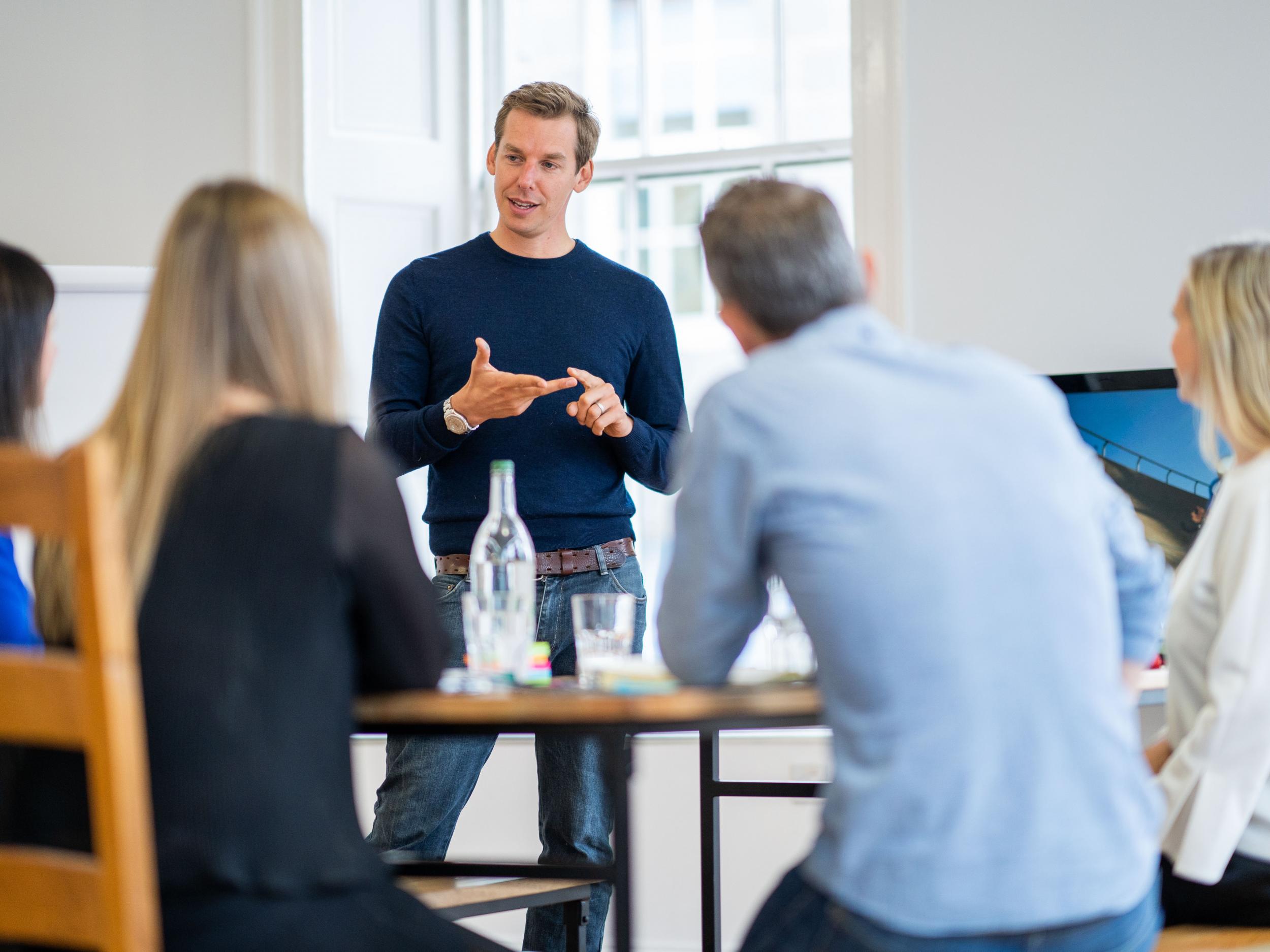How an Olympic swimmer is using his coaching skills to ease stress in the boardroom
Former athlete David Carry talks to Andy Martin about how he is using biometrics to help stressed-out FTSE 100 employees


David Carry first learned to swim aged three in the chilly waters off Aberdeen. Without a wetsuit. It must have made everything he did afterwards seem relatively easy. “I loved the water,” he says. “A lot of my identity was wrapped up in being the swimmer.” When he was 10 he got a new headmaster – Ian Black, Olympic swimmer and BBC Sports Personality of the Year 1958 – and his sporting destiny was sealed. Now, with Track Record, aged 38, Carry is taking lessons from the poolside out to the wider world.
“I loved the transparency of swimming,” he says. Input and output were clearly aligned. “I knew that if you’d done the work, you were more likely to get the result.” In those days (before he married open water specialist and double world champion Keri-anne Payne) he preferred the clarity of the pool to murky open water. “If it didn’t smell of chlorine and I couldn’t see the bottom, I didn’t trust it.” All his friends would come and watch him swim and he gradually built up confidence in the pool and beyond.
Then in 2004, aged 22, he was picked for the Athens Olympic squad, swimming in the relay. A tremendous high was followed by a devastating low when he was dropped at the last minute for the final. He picked himself up and went on to win two golds at the following Commonwealth Games in Melbourne.
He qualified for the Beijing Olympics in 2008, and his relay team nailed the British record but missed out on a medal by 0.8 of a second. It was a crushing moment. “I was still wet when the performance director came up to me and showed me a graph. I was the second-fastest swimmer in the world for 75 per cent of the race. But for the other 25 per cent I was not even in the top 100.” His weak spot was the turns. His ego took a hit until he had a realisation: “I had to separate who I was from my performance. Somebody should have told me about the 25 per cent sooner.”
Rather than being defensive, he decided he needed more information if he wanted to get better. This was at a time when British cycling, garlanded with gold medals galore, was dominant. Then cycling’s performance scientist, Scott Gardner, joined the swimming squad, and results were transformed. “We simply didn’t know what we were doing before,” says Carry.
His attention to detail was incredible. We had to do everything we could to minimise injury and illness. We even had surgeons come in to show us how to wash our hands properly
On Gardner’s first day at the pool, Carry was determined to show the new boy what swimming was all about. With Gardner looking on, he pulled out 10 reps of 400m freestyle, with only five seconds rest in-between. He had an average heart rate of 185 for 50 minutes. “There,” he said at the end of it all. “What do you think of that?” “Impressive,” Gardner responded. “But what part of your Olympic final were you practising there?” Carry was doing 80 or 90km every week but 30 per cent of his training, he realised, was completely wasted effort. It was actually counterproductive, building muscle that he didn’t need for his discipline.
Gardner gave him focus. They scrapped everything in his old regime and started again. Gardner had no technical knowledge of swimming but he was ruthlessly analytical. What he wanted to achieve – as in cycling – was maximum propulsion and minimum drag. “We had forgotten the drag,” says Carry. “His attention to detail was incredible. We had to do everything we could to minimise injury and illness. We even had surgeons come in to show us how to wash our hands properly. We didn’t go into competitions relying on hope any more. It was all about the science of hydro-dynamics – how the body moves through water.”
They talk of a ‘pre-mortem’ ie ask yourself what is likely to mess you up before it happens rather than afterwards
In the London Olympics of 2012, David Carry made it to the 400m freestyle final, at the age of 30. It was his first Olympic solo final. He came home seventh but “it was the closest I got to realising my full potential as a swimmer”. At which point he retired from swimming and became an executive coach, translating his experiences into the boardroom. “It wasn’t the medals, it was more those moments of realisation I wanted to share with people.”
In 2016 Carry joined forces with his old training guru Scott Gardner – then head coach of GB canoeing – to set up Track Record. They zeroed in on a single question: what does it take to win? They did research into astronauts and SAS soldiers as well as elite sports people. And they came back with one big idea: confidence. Not the sublime kind, but more scientific. Not based on hope or optimism but derived from a sense of having done your research properly. They talk of a “pre-mortem”, ie ask yourself what is likely to mess you up before it happens rather than afterwards. Another key word is “resilience”: the ability to deal with stress and then recover – which, Carry stresses, is trainable.
They recruited Katherine Moore, head of sports science and medicine for the GB Olympic canoeing team, and Dr Hannah McCloud, who was the equivalent on the hockey team. Together they have produced a book, Take Control of Your Confidence (with a foreword by Clare Balding), setting out their programme, which is designed to boost your performance and restore your sense of control in just about any field. Or just life generally.
“There’s a bunch of myths surrounding the ability to deal with stress,” says Carry. “We apply a biometric measure, separating fact and opinion. You get a readout that tells you about your stress levels and then we can work on increasing resilience.” They have fitted FTSE 100 executives with their monitors, measuring not just heart but brain function (“the cognitive load”). He gives a real example of one stressed-out senior manager who had had a public falling out and then hopped into his car and proceeded to drive into a wall (unintentionally). “People can hide it but our monitors show it up. Then you can do something about it, before you hit the wall.”
Join our commenting forum
Join thought-provoking conversations, follow other Independent readers and see their replies
Comments
Bookmark popover
Removed from bookmarks